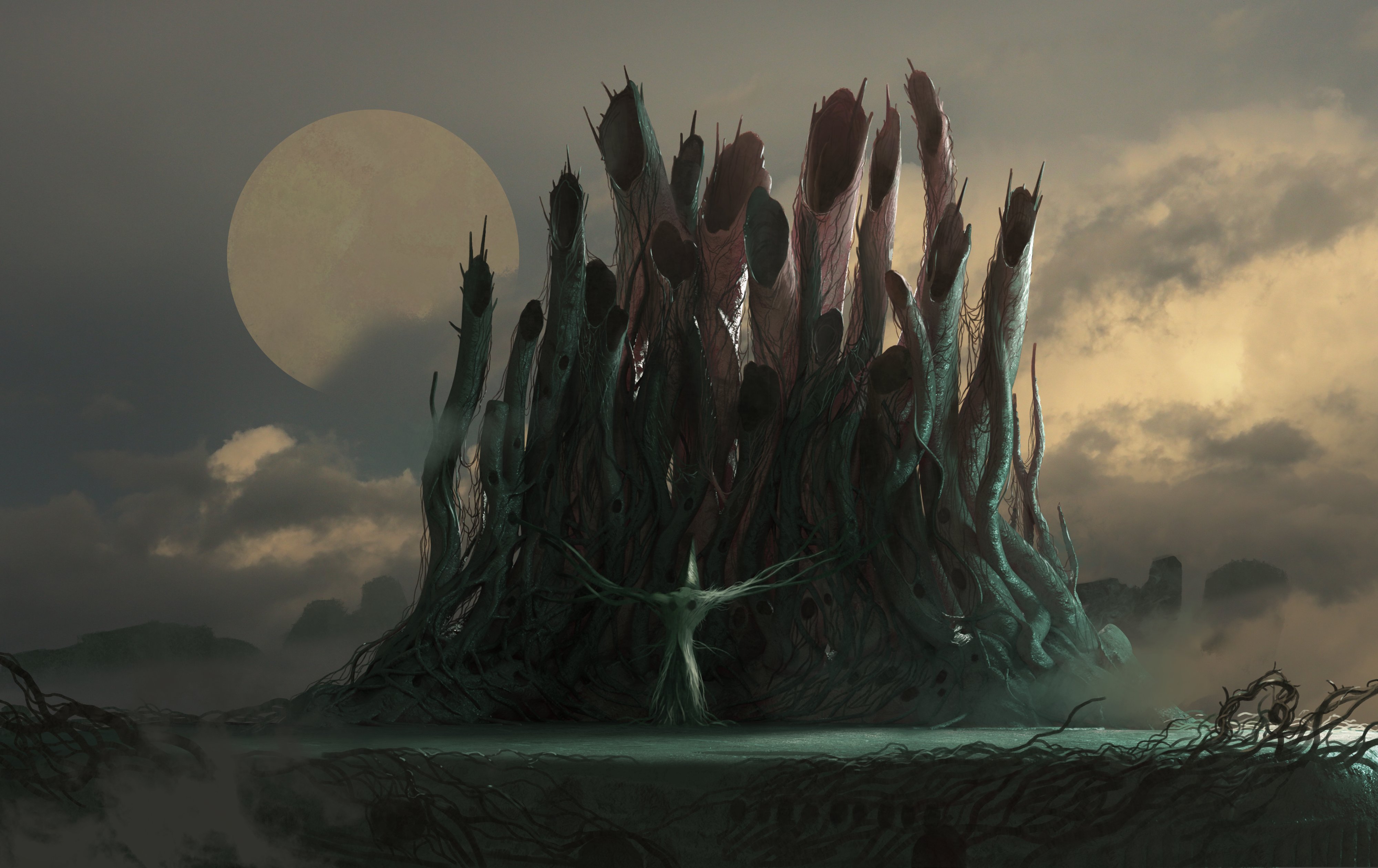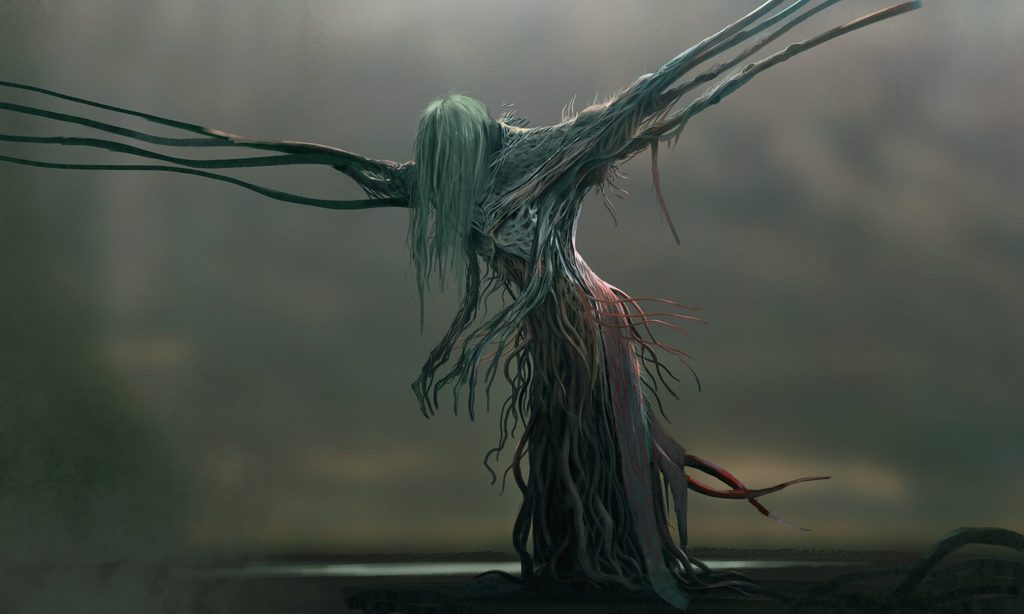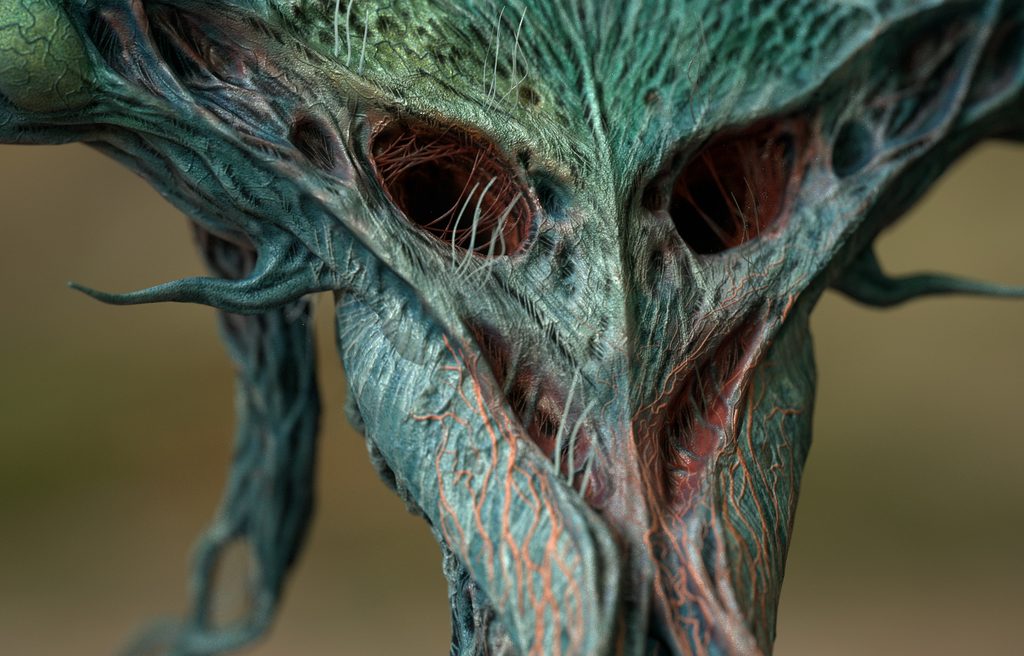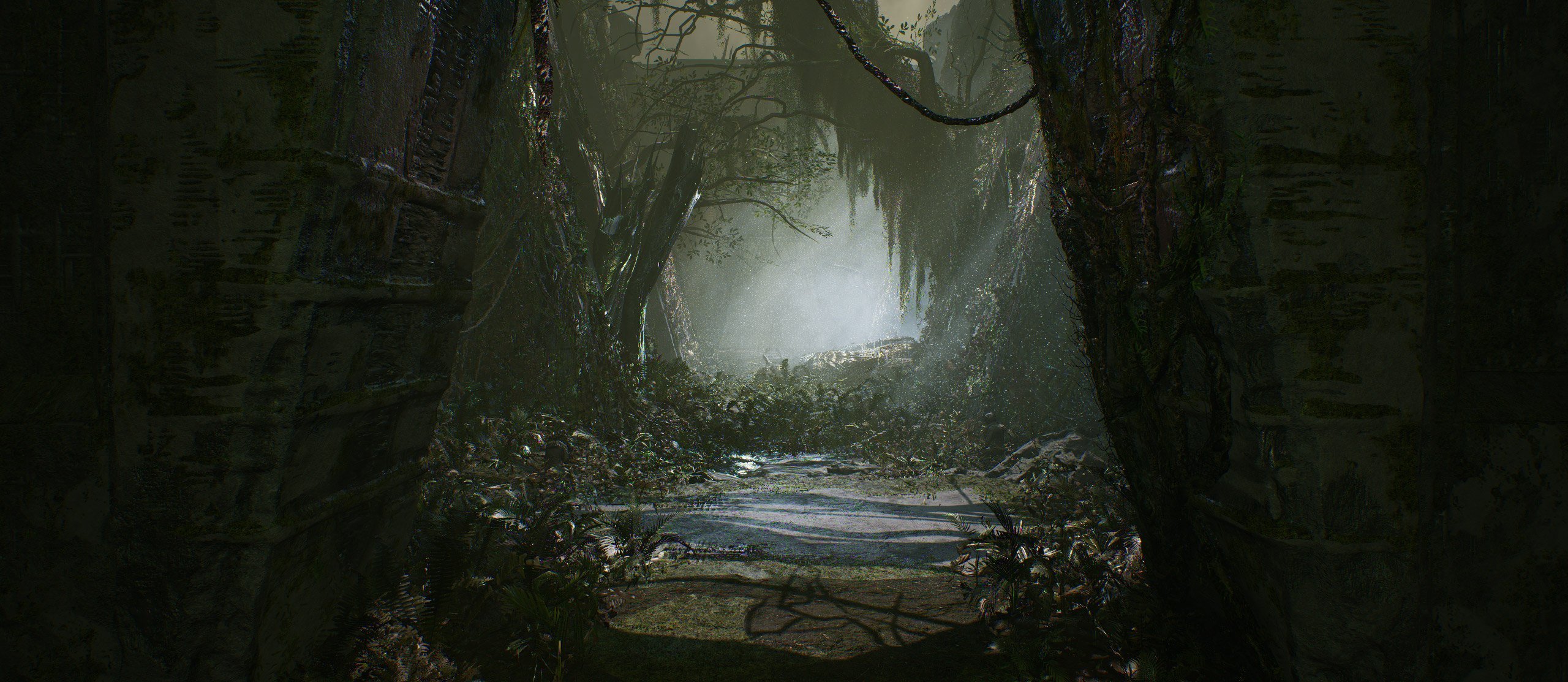Hey everyone, we’ve been very happy to see Returnal resonating so strongly with players, and this time we wanted to do a deep dive into one of our Bosses. In general, Boss battles have always been an essential test of skill for players in action games, and of course they’ve been a strong staple of the Housemarque formula in our past titles as well. With Returnal we really wanted to dedicate some time to create something special for our Boss encounters, and provide players with some powerful and memorable moments. We’ve been thrilled to see that players have been enjoying our Bosses so far, and today we wanted to share some notes on Hyperion, who seems to have quickly become a favorite among players!
SPOILER WARNING: this piece contains spoilers about the story of Returnal. It’s generally recommended that you read this only after defeating Hyperion, and ideally have seen credits roll.
The inspiration
From the very beginning, our goal with the story of Returnal was to haunt the player. On a personal level, many special and haunting moments I’ve experienced in games and film have often been accompanied by powerful music. In many cases I feel that music can be single-handedly responsible for creating the emotional impact and mood of a scene. This ability of music itself to express very complex, raw emotions in a unique way – to express the intangible – was the initial seed of inspiration here.
This importance of music was also directly woven into our story, along with our other central elements and themes early on. It started by envisioning our key story beats (beginning, middle and especially our end), and then consciously working backwards from there: identifying which puzzle pieces we would seed throughout the experience to get under the player’s skin, and create the feeling of an overarching, layered mystery for players to solve.
One of the crucial puzzle pieces was intended to be a specific piece of music, and throughout the game there are multiple clues that a particular melody is very important to Selene. (Note that I’m being intentionally vague to avoid spoiling too much here!)
In parallel, we also knew that we’d want to have some epic bosses in the game. These would need to be memorable highlights that would provide a challenge for players and serve as milestones of progress, but they would also need strongly resonate with players emotionally and be thematically tied to our story as well. In addition to the harsh, dark sci-fi elements of Returnal, we also wanted to explore some more psychological/surreal themes with our story. Our Bosses would serve as climactic manifestations of those themes. So from very early on we knew that we’d have one Boss that would play with this theme of musicality. This boss was simply codenamed “The Musician” internally, eventually this became Hyperion.
The idea for the Musician came first, and then the rest of the Echoing Ruins was built around it to support its presence.
“The Musician’s” visual design
There were some keywords we used to guide our initial concepting for Hypersion: unsettling, musicality, tragic, dramatic, theatricality. Much like our other Bosses, we wanted to make this encounter feel majestic. And what could possibly be more majestic than using an alien Church Organ?
I’ve always found the church organ to be one of my favorite instruments (and has been tied to many of my favorite Boss battles in games), and its ability to express grandeur is simply unmatched. It’s also a very beautiful organ in itself, and there was a lot of inspiration drawn from researching large Cathedral church organs. Their massive scale, how they utilize air to practically “breathe” life into melodies, and how their range can express both extremely delicate sounds but also be very imposing and bombastic when… It feels alive and powerful – the perfect fit for Returnal.
The Musician himself was envisioned mostly as a tragic figure: a creature that is bound to this otherworldly organ through multiple organic vines and tentacles, fused in a nightmarish, symbiotic relationship. The Musician is clearly obsessed with playing this haunting melody repeatedly – much like Selene is also haunted by it – and now that it’s bound to the organ it’s destined to be trapped there playing this melody forever. The hunched over look was inspired by virtuoso pianists, who often appear to be in a meditative trance when playing their tunes. Musician, instrument and music are one and inseparable.
From the early stages we also had the idea of making the back of the boss appear like it could also be its front. We wanted to combine the imagery of the Musician’s back piece being forcibly bound (almost in a ritualistic manner) to the organ via the organic vines, while also keeping his arms free to play the instrument in the front as well. We also added some subtle facial characteristics on its back, to make the encounter feel slightly more unsettling and also give the player something more recognizable to shoot at (as otherwise its thin silhouette would also get lost amongst the vines and details).
Now let’s look at how we built towards the encounter between Selene and Hyperion in-game, as well as the design of the battle itself. Extra insight comes from Returnal’s Principal Music Producer Joe Thwaites and Senior Game Designer John Hollingworth.
Act I – Failed escape and the song’s setup
Right before Selene reaches the Echoing Ruins, she experiences our “Failed Escape” ending. In this cinematic, Selene returns to Earth and finds herself haunted by many memories and she tries to resume a normal life. One of these haunting memories seems strongly tied to this particular melody, which just pours out when she sits in front of a piano again. She doesn’t remember exactly why it’s important yet, only that it is. She’ll become obsessed with this melody for the rest of her life. The cinematic ends with her – now aged – hands playing it one last time. She takes the mystery of the music with her to her grave.
Act II – The Cycle continues and the ascension
Selene dies, and reawakens on Atropos. One of the first things she notices is that same melody playing, as if the planet is using it to torment her further.
Joe Thwaites: “The key objective [of the Echoing Ruins] is to find the source. This melody floats in and out of the ambient, environmental music: if you stop to listen, you can hear the distant sounds of the alien organ float in the wind. We used 3D audio capabilities* to position the melody in the environment. As you move through the level, the melody will play from the direction of the Echoing Vault, helping to lead the player to the source of the music. Pass through the Echoing Vault and you entire the spire… Hyperion’s resting ground.
As you explore the Echoing Ruins, you encounter various hollow plants that seem to be playing the same melody. They all seem to suggest that there’s a central source of this music – an extra riddle for Selene to solve.
“As you stand at the bottom of the spire, the arpeggiated organ tune that you have been following echoes through the environment, giving the sense that you are standing inside a cathedral. As you climb the spire, the clearer that music becomes. We wanted to create the feeling of moving towards the objective. We used the distance from the top of the spire as a parameter to add new layers and feed intensity into the music. We also add layers of saturation as you approach the top, giving the sense that the alien organ is so loud that it’s distorting.”
When you work your way to the top, you’re confronted with a surreal sight: this huge creature obsessively – yet serenely – playing an organic church-like organ.
Joe Thwaites: “Once the player steps into the arena the mood changes and the pace picks up.”
Act III – The Bullet Ballet
For our boss battle, we wanted The Musician to utilize the organ. It would demonstrate its mastery of the organ (and attached vines/tentacles) to attack Selene with a cacophony of bullets and a cosmic symphony of explosions. There would be multiple attack types that would resemble spores to tie into the organic nature of the organ, and lots of bullet hell patterns to drive our avoidance gameplay.
Joe Thwaites: “The tune that you have been following is now played at a much faster tempo and in conjunction with Bobby Krilic’s much more intense boss fight score. As the fight plays out, the music intensifies with each phase, introducing more elements, fuller percussion, and thicker harmonic textures.”
John Hollington: “The objective of the combat design was to mirror the dominating, escalating soundtrack. With each passing phase the difficulty and intensity increases, Hyperion plays the Organ near the end of each phase to unleash new chords of destruction at the player.”
Joe Thwaites: “Hyperion’s obsession with the tune and the repetitive nature of this arpeggio creates a relentless wall of sound that accompanies the barrage of projectiles that emanate from the organ. The organ sound itself is made-up of a combination of real and synthetic organs put through some processing to make the sound aggressive and alien. This sits really nicely with Bobby Krilic’s percussive and synth-driven score which kicks in when the combat starts.”
John Hollington: “Similar to a single musical note, each attack from the barrel of the organ doesn’t provide much on it’s own, but when they all come together in sequence it provides a challenging bullet hell symphony which forces the player to keep moving until it is silenced.
“Every pattern was carefully balanced and tweaked from countless amounts of testing. As a team we were always pushing for bigger attacks, more bullets and impressive chaotic patterns, particularly for the Organ. However, we were very cautious of difficulty and readability. The visual language of the projectiles play an enormous role in that. By contrasting them clearly against each other it allows the player to quickly and easily identify the patterns and react to the attacks.
“The colour of projectiles used represent the style of attack. Green is commonly used for more random, non-direct clusters (Low reaction response from the player). Orange is reserved for slower moving non-targeting shapes that consume space (Medium player reaction) and blue projectiles are for Hyperion’s main attacks, they are often direct and require the player to quickly respond to the threat (High reaction). These consistent colour-coordinated layers work together and overlap to create a truly chaotic scene, but one which allows the player to work around, read the threats clearly and slip through the designed gaps.
The attacks need to present themselves so even if the player is completely overwhelmed at first, after time, practice and experience the boss could be defeated without the player taking a single hit of damage. This was something we would have to prove before we submitted each iteration.”
Throughout the battle the vines are progressively broken and detached from its back piece, unknowingly “liberating” the Musician from the clutches of the organ. Yet even without this constraint, the Musician still returns to the solace of the organ for one final time as he senses his end drawing near in the final phase. This draws further symmetry with Selene’s story in the Failed Escape, where Selene is also seen repeatedly playing this melody just moments before her death as well.
Act IV – The silence
Just like many encounters in Returnal, the Musician also plays an important role in Selene’s story. Defeating Hyperion marks a bittersweet moment in Selene’s journey: although she silences the song, the haunting melody still lingers in her mind as she keeps exploring its significance. Along with the players sharing her journey, they will discover the significance of this song (and much more) later in the game together.
Thanks so much for reading about the origins of Hyperion, and thanks to players who have stepped in the haunting world of Atropos. Returnal is available now on PS5.
*3D audio requires stereo headphones (analogue or USB).
Source: Playstation Blog
—




